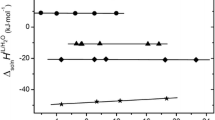Abstract
The methods of23Na and7Li NMR, EPR and conductimetry have been used to investigate the intermolecular interactions in systems consisting of the anion-radical salt of an alkali metal and a crown ether, dissolved in acetonitrile. Relations have been established between the structure of the complexes formed in solution, their magnetic resonance characteristics, and their limiting conductance. For solutions of anionradical salts in the presence of an excess of crown ether additional routes for conductance have been identified, connected with electron exchange reactions between the molecules of organic π-acids in different charge states.
Similar content being viewed by others
Literature cited
V. S. Kuts and O. V. Zhalko-Titarenko, “The effect of complex formation on the electrical conductivity in systems consisting of anion radical salt, crown ether and polar solvent,” Teor. Éksp. Khim.,22, No. 2, 188–196 (1986).
J. Takada, H. Jano, M. Ishimashi, and H. Isozumi, “A conductance study of alkalimetal ion 15-crown-5 and dibenzo-24-crown-8 complexes in propylene carbonate,” Bull. Chem. Soc. Jpn.,53, No. 1, 72–76 (1980).
R. C. Phillips, S. Khazaeli, and J. L. Dye, “Sodium-23 NMR study of sodium bromide in methylamine solutions that contain macrocyclic polyethers,” J. Phys. Chem.,89, No. 4, 600–606 (1985).
Ch. A. Kraus and R. M. Fuoss, “The evaluation of λ∞ and K for incompletely dissociated electrolytes,” J. Am. Chem. Soc.,55, No. 2, 476–491 (1933).
A. S. Weissberger, E. G. Proskauer, J. A. Riddick, and E. E. Toops, Organic Solvents: Physical Properties and Methods of Purification [Russian translation], Izd. Inostr. Lit., Moscow (1958).
A. A. Egorenkov, Yu. V. Mitnik, M. A. Alesherov, and T. M. Guseinova, “The purification of crown ethers” [in Russian], Dep. VINITI April 2, 1984, No. 1832, Moscow (1984).
D. S. Acher, R. J. Harder, W. R. Hertler, et al., “7,7', 8,8'-Tetracyanoquinodimethane and its electrically conducting anion derivatives,” J. Am. Chem. Soc.,82, No. 24, 6408–6409 (1960).
J. A. Pople and G. A. Segal, “Approximate self consistent molecular orbital theory. 3. CNDO results for AB2 and AB3 systems,” J. Chem. Phys.,44, No. 9, 3289–3296 (1966).
J. D. Lin and A. I. Popov, “NMR studies of some sodium ion complexes with crown ethers and [2.2.2]cryptands in various solvents,” J. Am. Chem. Soc.,103, No. 13, 3773–3777 (1981).
T. Takeshita and N. Hirota, “Signs of alkali metal splittings and the structure of ion pair radical ions,” Chem. Phys. Lett.,4, No. 6, 369–372 (1969).
J. Berts and J. Bolton, Theory and Practical Applications of the EPR Method [Russian translation], Izd. Mir, Moscow (1975).
V. S. Kuts and Yu. A. Kruglyak, “The analysis of poorly resolved EPR Spectra of free radicals. Radiospectroscopic and quantum-chemical methods of investigating molecular structure,” [in Russian], pp. 157–164, Izd. Nauka, Moscow (1967).
Z. G. Soos, Organic Molecular Crystals: Charge-Transfer Complexes. Treatise on Solid State Chemistry, Vol. 3, pp. 679–767 (1976).
J. G. Sharp and M. C. R. Symons, Investigation of Ion Pairs by the Method of Paramagnetic Resonance. Ions and Ion Pairs in Organic Reactions [Russian translation], Izd. Mir, Moscow (1975), pp. 196–291.
K. I. Zamaraev, Yu. N. Molin, and K. M. Salikhov, Spin Exchange. Theory and Physicochemical Applications [in Russian], Izd. Nauka, Novosibirsk (1977).
V. É. Kampar, S. P. Valtere, and O. Ya. Neiland, “Determination from IR spectra of the extent of charge transfer in π-π complexes of 7,7', 8,8'-tetracyanoquinodimethane,” Teor. Éksp. Khim.,14, No. 3, 369–373 (1978).
I. Ruff and V. J. Friedrich, “Transfer diffusion. 1. Theoretical,” J. Phys. Chem.,75, No. 21, 3297–3302 (1971).
K. Suga, T. Yorifuji, and Sh. Acyadni, “Verification of the transfer diffusion theory by electric conductivity measurement,” Electrochem. Acta,27, No. 9, 1259–1261 (1982).
Author information
Authors and Affiliations
Additional information
Translated from Teoreticheskaya i Éksperimental'naya Khimiya, Vol. 25, No. 2, pp. 173–182, March–April, 1989.
Rights and permissions
About this article
Cite this article
Kuts, V.S., Zhalko-Titarenko, O.V., Tsekhmistrenko, L.F. et al. Nature of intermolecular interactions and conductance in a system consisting of alkali metal ions, crown ether, anion radicals, and a polar solvent. Theor Exp Chem 25, 158–165 (1989). https://doi.org/10.1007/BF01135005
Received:
Issue Date:
DOI: https://doi.org/10.1007/BF01135005




